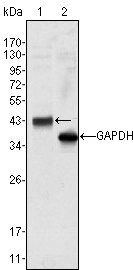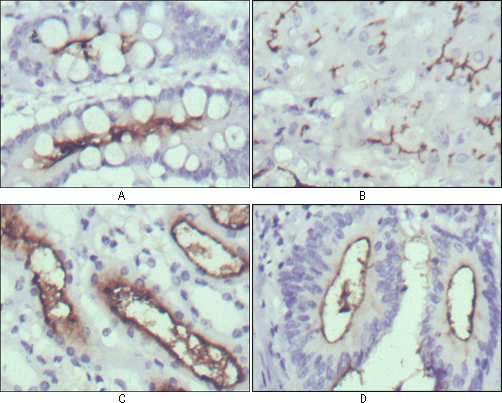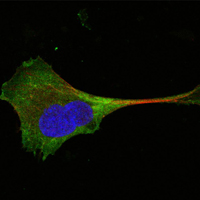Wnt-10b Monoclonal Antibody
- Catalog No.:YM0650
- Applications:WB;IHC;IF;ELISA
- Reactivity:Human
- Target:
- Wnt-10b
- Fields:
- >>mTOR signaling pathway;>>Wnt signaling pathway;>>Hippo signaling pathway;>>Signaling pathways regulating pluripotency of stem cells;>>Melanogenesis;>>Cushing syndrome;>>Alzheimer disease;>>Pathways of neurodegeneration - multiple diseases;>>Human papillomavirus infection;>>Pathways in cancer;>>Proteoglycans in cancer;>>Basal cell carcinoma;>>Breast cancer;>>Hepatocellular carcinoma;>>Gastric cancer
- Gene Name:
- WNT10B
- Protein Name:
- Protein Wnt-10b
- Human Gene Id:
- 7480
- Human Swiss Prot No:
- O00744
- Mouse Swiss Prot No:
- P48614
- Immunogen:
- Purified recombinant fragment of human Wnt-10b expressed in E. Coli.
- Specificity:
- Wnt-10b Monoclonal Antibody detects endogenous levels of Wnt-10b protein.
- Formulation:
- Liquid in PBS containing 50% glycerol, 0.5% BSA and 0.02% sodium azide.
- Source:
- Monoclonal, Mouse
- Dilution:
- WB 1:500 - 1:2000. IHC 1:200 - 1:1000. IF 1:200 - 1:1000. ELISA: 1:10000. Not yet tested in other applications.
- Purification:
- Affinity purification
- Storage Stability:
- -15°C to -25°C/1 year(Do not lower than -25°C)
- Other Name:
- WNT10B;WNT12;Protein Wnt-10b;Protein Wnt-12
- Molecular Weight(Da):
- 43kD
- References:
- 1. Oncogene. 1997 Mar 13;14(10):1249-53.
2. Int J Oncol. 2001 Dec;19(6):1187-92.
- Background:
- The WNT gene family consists of structurally related genes which encode secreted signaling proteins. These proteins have been implicated in oncogenesis and in several developmental processes, including regulation of cell fate and patterning during embryogenesis. This gene is a member of the WNT gene family. It may be involved in breast cancer, and its protein signaling is likely a molecular switch that governs adipogenesis. This protein is 96% identical to the mouse Wnt10b protein at the amino acid level. This gene is clustered with another family member, WNT1, in the chromosome 12q13 region. [provided by RefSeq, Jul 2008],
- Function:
- developmental stage:Infant brain has higher levels of WNT10B than adult brain.,function:Ligand for members of the frizzled family of seven transmembrane receptors.,function:Ligand for members of the frizzled family of seven transmembrane receptors. Probable developmental protein. May be a signaling molecule which affects the development of discrete regions of tissues. Is likely to signal over only few cell diameters.,similarity:Belongs to the Wnt family.,tissue specificity:Detected in most adult tissues. Highest levels were found in heart and skeletal muscle. Low levels are found in brain.,
- Subcellular Location:
- Secreted, extracellular space, extracellular matrix . Secreted .
- Expression:
- Detected in most adult tissues. Highest levels were found in heart and skeletal muscle. Low levels are found in brain.
- June 19-2018
- WESTERN IMMUNOBLOTTING PROTOCOL
- June 19-2018
- IMMUNOHISTOCHEMISTRY-PARAFFIN PROTOCOL
- June 19-2018
- IMMUNOFLUORESCENCE PROTOCOL
- September 08-2020
- FLOW-CYTOMEYRT-PROTOCOL
- May 20-2022
- Cell-Based ELISA│解您多样本WB检测之困扰
- July 13-2018
- CELL-BASED-ELISA-PROTOCOL-FOR-ACETYL-PROTEIN
- July 13-2018
- CELL-BASED-ELISA-PROTOCOL-FOR-PHOSPHO-PROTEIN
- July 13-2018
- Antibody-FAQs
- Products Images

- Western Blot analysis using Wnt-10b Monoclonal Antibody against HeLa cell lysate (1).

- Immunohistochemistry analysis of paraffin-embedded human normal stomach (A), normal liver (B), normal kidney (C) and rectum cancer tissues (D) with DAB staining using Wnt-10b Monoclonal Antibody.

- Confocal immunofluorescence analysis of PANC-1 cells using Wnt-10b Monoclonal Antibody (green). Red: Actin filaments have been labeled with Alexa Fluor-555 phalloidin. Blue: DRAQ5 fluorescent DNA dye.



